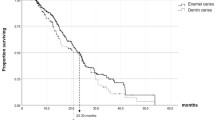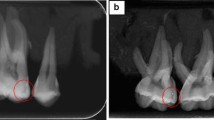Abstract
Objective
To assess the radiographic pattern of underlying dentine shadows (UDS) in the occlusal surfaces of permanent teeth.
Methods
A total of 282 permanent posterior teeth pertaining to 91 individuals, 142 UDS and 140 non-cavitated enamel lesions (NCEL), were included for comparison. UDS was defined as shadows of discolored dentin visible through the enamel surface which may or may not show signs of localized enamel breakdown, classified as code 4 by the International Caries Detection and Assessment System group. Data collection included the application of a questionnaire, clinical examination, and bilateral bitewing radiographs. The risk for presenting radiolucency was estimated using logistic regression model with generalized estimating equations.
Results
Approximately 79% of UDS exhibited no radiolucency. The proportion of teeth exhibiting a radiolucency restricted to the enamel-dentin junction was 20.4% for UDS and 3.6% for NCEL (p < 0.001, chi-square test). UDS had a sixfold increased risk for exhibiting radiolucency compared with NCEL (OR = 5.78, 95% CI = 2.73–12.22, p < 0.001). Despite this finding, it is important to highlight that virtually all cases were located at the enamel-dentin junction, and only one tooth in each category of clinical status exhibited radiolucency at the outer one half of dentin. No tooth exhibited radiolucency reaching the deep dentin.
Conclusion
The present study showed that UDS presented radiolucency in very few cases. The vast majority of lesions showed no radiolucency.
Clinical relevance
Our findings suggest that only a small proportion of UDS would demand restorative treatment.
Similar content being viewed by others
References
Baelum V, Heidmann J, Nyvad B (2006) Dental caries paradigms in diagnosis and diagnostic research. Eur J Oral Sci 114:263–277
Nyvad B, Machiulskiene V, Baelum V (1999) Reliability of a new caries diagnosis system differentiating between active and inactive caries lesions. Caries Res 33:252–260
Ismail AI, Sohn W, Tellez M, Amaya A, Sen A, Hasson H, Pitts NB (2007) The International Caries Detection and Assessment System (ICDAS): an integrated system for measuring dental caries. Community Dent Oral Epidemiol 35(3):170–178
Pitts NB, Ekstrand KR (2013) International Caries Detection and Assessment System (ICDAS) and its International Caries Classification and Management System (ICCMS) – methods for staging of the caries process and enabling dentists to manage caries. Community Dent Oral Epidemiol 41:e41–e52
Ekstrand KR, Martignon S, Ricketts DJN, Qvist V (2007) Detection and activity assessment of primary coronal caries lesions: a methodologic study. Oper Dent 32(3):225–235
Jablonski-Momeni A, Stachniss V, Ricketts DN, Heinzel-Gutenbrunner M, Pieper K (2008) Reproducibility and accuracy of the ICDAS-II for detection of occlusal caries in vitro. Caries Res 42:79–87
Rodrigues JA, Hug I, Diniz MB, Lussi A (2008) Performance of fluorescence methods, radiographic examination and ICDAS II on occlusal surfaces in vitro. Caries Res 42:297–304
Diniz MB, Rodrigues JA, Hug I, Cordeiro RC, Lussi A (2009) Reproducibility and accuracy of the ICDAS-II for occlusal caries detection. Community Dent Oral Epidemiol 37:399–404
Bertella N, dos Moura S, Alves LS, Damé-Teixeira N, Fontanella V, Maltz M (2013) Clinical and radiographic diagnosis of underlying dark shadow from dentin (ICDAS 4) in permanent molars. Caries Res 47(5):429–432
Maltz M, Barbachan e Silva B, Carvalho DQ, Volkweis A (2003) Results after two years of non-operative treatment of occlusal surface in children with high caries prevalence. Braz Dent J 14:48–54
Mejàre I, Axelsson S, Dahlén G, Espelid I, Norlund A et al (2014) Caries risk assessment. A systematic review. Acta Odontol Scand 72:81–91
Ekstrand KR, Ricketts DN, Kidd EA (1997) Reproducibility and accuracy of three methods for assessment of demineralization depth of the occlusal surface: an in vitro examination. Caries Res 31:224–231
Bakhshandeh A, Ekstrand KR, Qvist V (2011) Measurement of histological and radiographic depth and width of occlusal caries lesions: a methodological study. Caries Res 45(6):547–555
Elderton RJ (2003) Preventive (evidence-based) approach to quality general dental care. Med Princ Pract 12(Suppl 1):12–21
Ismail AI, Tellez M, Pitts NB, Ekstrand KR, Ricketts D, Longbottom C, Eggertsson H, Deery C, Fisher J, Young DA, Featherstone JD, Evans W, Zeller GG, Zero D, Martignon S, Fontana M, Zandona A (2013) Caries management pathways preserve dental tissues and promote oral health. Community Dent Oral Epidemiol 41(1):e12–e40
Ismail AI, Pitts NB, Tellez M, Authors of International Caries Classification and Management System (ICCMS), Banerjee A, Deery C, Douglas G, Eggertsson H, Ekstrand K, Ellwood R, Gomez J, Jablonski-Momeni A, Kolker J, Longbottom C, Manton D, Martignon S, McGrady M, Rechmann P, Ricketts D, Sohn W, Thompson V, Twetman S, Weyant R, Wolff M, Zandona A (2015) The International Caries Classification and Management System (ICCMS™) an example of a caries management pathway. BMC Oral Health 15(Suppl 1):S9
Funding
This study was funded by the researchers.
Author information
Authors and Affiliations
Corresponding author
Ethics declarations
Conflict of interest
The authors declare that they have no conflict of interest.
Ethical approval
The study protocol was approved by the Research Ethics Committee of the Federal University of Santa Maria (number 62517416.6.0000.5346). All procedures were in accordance with the ethical standards of this research committee and with the 1964 Helsinki declaration and its later amendments or comparable ethical standards.
Informed consent
All subjects and their parents/legal guardians were informed on the research risks and purposes and signed a written informed consent. When necessary, patients received dental care by the researchers. No financial incentive was paid for the participants.
Additional information
Publisher’s note
Springer Nature remains neutral with regard to jurisdictional claims in published maps and institutional affiliations.
Rights and permissions
About this article
Cite this article
Marquezan, P.K., Alves, L.S., Dalla Nora, A. et al. Radiographic pattern of underlying dentin lesions (ICDAS 4) in permanent teeth. Clin Oral Invest 23, 3879–3883 (2019). https://doi.org/10.1007/s00784-019-02818-y
Received:
Accepted:
Published:
Issue Date:
DOI: https://doi.org/10.1007/s00784-019-02818-y




